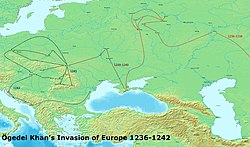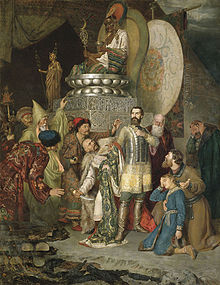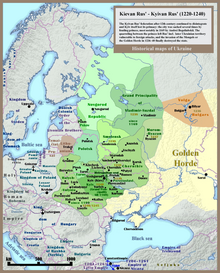Mongol invasion of Kievan Rus’
Jump to navigationJump to search
| Mongol conquest of Eastern Europe | |||||||
|---|---|---|---|---|---|---|---|
 Mongol invasion of Europe, 1236-1242 |
|||||||
|
|||||||
| Belligerents | |||||||
| Mongol Empire | |||||||
| Commanders and leaders | |||||||
| Strength | |||||||
1236:
1223:
|
1236:
|
||||||
| Casualties and losses | |||||||
| Unknown | 500,000 (6–7% of the population of Rus)[3] | ||||||
The Mongol conquest of Kievan Rus’ was part of the Mongol invasion of Europe, in which the Mongol Empire invaded and conquered Kievan Rus’ and other Russian principalities in the 13th century, destroying numerous cities, including Ryazan, Kolomna, Moscow, Vladimir and Kiev.[4][5]
The campaign was heralded by the Battle of the Kalka River in May 1223, which resulted in a Mongol victory over the forces of several Rus’ principalities. The Mongols retreated, having gathered their intelligence which was the purpose of the reconnaissance-in-force. A full-scale invasion of Rus’ by Batu Khan followed, from 1237 to 1242. The invasion was ended by the Mongol succession process upon the death of Ögedei Khan. All Rus’ principalities were forced to submit to Mongol rule and became vassals of the Golden Horde empire, some of which lasted until 1480.
The invasion, facilitated by the beginning of the breakup of Kievan Rus’ in the 13th century, had incalculable ramifications for the history of Eastern Europe, including the division of the East Slavic people into three separate nations: modern-day Russia, Ukraine and Belarus,[6] and the rise of the Grand Duchy of Moscow.
Background[edit]
As it was undergoing fragmentation, Kievan Rus’ faced the unexpected invasion of foreign foe coming from the mysterious regions of the Far East. “For our sins”, writes the Rus’ chronicler of the time, “unknown nations arrived. No one knew their origin or whence they came, or what religion they practiced. That is known only to God, and perhaps to wise men learned in books”.[7]
The princes of Rus’ first heard of the coming Mongol warriors from the nomadic Cumans. The historical accounts after the initial invasion call them by the name Tartars. They were previously known for pillaging settlers on the frontier, the nomads now preferred peaceful relations, warning their neighbors: “These terrible strangers have taken our country, and tomorrow they will take yours if you do not come and help us”. In response to this call, Mstislav the Bold and Mstislav Romanovich the Old joined forces and set out eastward to meet the foe, only to be routed on April 1, 1223, at the Battle of the Kalka River.
Although this defeat left the Rus’ principalities at the mercy of invaders, the Mongol or Tartar forces retreated and did not reappear for thirteen years, during which time the princes of Rus’ went on quarrelling and fighting as before, until they were startled by a new and much more formidable invading force. In the Secret History of the Mongols, the only reference to this early battle is:
“Then he (Chinghis Khan) sent Dorbei the Fierce off against the city of Merv, and on to conquer the people between Iraq and the Indus. He sent Subetei the Brave off to war in the North where he defeated eleven kingdoms and tribes, crossing the Volga and Ural Rivers, finally going to war with Kiev.”
Invasion of Batu Khan[edit]
The vast Mongol(Tartar) army of around 40,000 [8] mounted archers, commanded by Batu Khan and Subutai, crossed the Volga River and invaded Volga Bulgaria in late 1236. It took them only a month to extinguish the resistance of the weak Volga Bulgars, the Cumans–Kipchaks and the Alans.
In November 1237, Batu Khan sent his envoys to the court of Yuri II of Vladimir and demanded his submission. A month later, the Tartar hordes besieged Ryazan. After six days of bloody battle, the city was totally annihilated and inhabitants slaughtered.[5] Alarmed by the news, Yuri II sent his sons to detain the invaders, but they were defeated and ran for their lives. Having burnt down Kolomna and Moscow, the horde laid siege to Vladimir on February 4, 1238. Three days later, the capital of Vladimir-Suzdal was taken and burnt to the ground. The royal family perished in the fire, while the grand prince retreated northward. Crossing the Volga, Vladimir mustered a new army, which was encircled and totally annihilated by the Mongols in the Battle of the Sit River on March 4.
Thereupon Batu Khan divided his army into smaller units, which ransacked fourteen cities of modern-day Russia: Rostov, Uglich, Yaroslavl, Kostroma, Kashin, Ksnyatin, Gorodets, Galich, Pereslavl-Zalessky, Yuriev-Polsky, Dmitrov, Volokolamsk, Tver and Torzhok. Chinese siege engines were used by the Mongols under Tului to raze the walls of Rus’ cities.[9] The most difficult to take was the small town of Kozelsk, whose boy-prince Vasily, son of Titus, and inhabitants resisted the Mongols for seven weeks, killing 4,000. As the story goes, at the news of the Mongol approach, the whole town of Kitezh with all its inhabitants was submerged into a lake, where, as legend has it, it may be seen to this day. The only major cities to escape destruction were Novgorod and Pskov. The Mongols planned to advance on Novgorod, but the principality was spared the fate of its brethren by the wise decision to preemptively surrender.[10]
In mid-1238, Batu Khan devastated the Crimea and pacified Mordovia. In the winter of 1239, he sacked Chernihiv and Pereiaslav. After many days of siege, the horde stormed Kiev in December 1240. Despite the resistance of Danylo of Halych, Batu Khan managed to take two of his principal cities, Halych and Volodymyr-Volynskyi. The Mongol Tartars then resolved to “reach the ultimate sea”, where they could proceed no further, and invaded Hungary (under Batu Khan) and Poland (under Baidar and Kaidu).[5] Batu Khan captured Pest, and then on Christmas Day 1241, Esztergom.[5]
Age of Tatar rule[edit]
|
|
This section has been nominated to be checked for its neutrality. (November 2018) (Learn how and when to remove this template message)
|
Prince Michael of Chernigov was passed between fires in accordance with ancient Turco-Mongol tradition. Batu Khan ordered him to prostrate himself before the tablets of Genghis Khan. The Mongols stabbed him to death for his refusal to do obeisance to Genghis Khan’s shrine.
This time the invaders came to stay, and Batu Khan built a capital, called Sarai, or Sarai Batu ( Batu’s Palaces) on the lower Volga. Here the commander of the Golden Horde, as the western section of the Tartar or Mongol empire was called, fixed his golden palace city and represented his sovereign the grand khan who lived with the Great Horde in the Orkhon Valley. Here they had their headquarters and held parts of Rus’ in subjection for nearly three centuries. All of the Russian states, including Novgorod, Smolensk, Galich and Pskov, submitted to the Tatar-Mongol rule.[11]
The term by which this subjection is commonly designated, the Mongol or Tatar “yoke”, suggests terrible oppression, but in reality these nomadic invaders from Mongolia were not such cruel, oppressive taskmasters.[12] In the first place, they never settled in the country, and they had little direct dealing with the inhabitants. In accordance with the admonitions of Genghis Khan to his children and grandchildren, they retained their pastoral mode of life, so that the subject peoples, agriculturists and dwellers in towns were not disturbed in their ordinary avocations. The Golden Horde Tartars instituted census, taxes and tributes on the conquered lands, which were usually collected by local princes and brought to Sarai. It was only in the 14th and 15th centuries, with the rise of the Tatar khanates, that slave raids on the Slavic population became significant, with the purpose of trading slaves with the Ottoman Empire. The raids were catastrophic for both Muscovy and the Grand Duchy of Lithuania, and they largely prevented the settlement of the “Wild Fields” – the Russian steppes extending from about 160 kilometres (100 miles) south of Moscow to the Black Sea – and they ultimately contributed to the development of the Cossacks.
In religious matters, the Mongols were extremely tolerant. When they first appeared in Europe, they were shamanists, and as such they had no religious fanaticism. After adopting Islam they remained as tolerant as before,[13] and the khan of the Golden Horde, who first became a Muslim, allowed the Rus’ to found a Christian bishopric in his capital. Nogai Khan, half a century later, married a daughter of the Byzantine emperor and gave his own daughter in marriage to a Rus’ prince, Theodor the Black. Some modern revisionist Russian historians (most notably the Soviet era historian and “Neo-Eurasianist” ideologist Lev Gumilev) even postulate that there was no invasion at all. According to them, the Rus’ princes concluded a defensive alliance with the Horde in order to repel attacks of the fanatical Teutonic Knights, which posed a much greater threat to the Rus’ religion and culture.
These points represent the bright side of Tartar rule. So long as a powerful kingdom of nomads was established on the doorstep of Russia, the country was under threat and liable to be overrun at anytime by them. Though invasions were not frequent, but when they occurred they caused an incalculable amount of devastation and suffering. In the intervals the people had to pay a fixed tribute. At first it was collected by Tatar tax-gatherers; by about 1259 it was regulated by a census of the population; and finally its collection was entrusted to the native princes, so the people were no longer brought into direct contact with the Tatar officials.
Impact on development[edit]
|
Part of a series on the
|
|---|
| History of East Slavs |
| Middle Ages |
| Early Modern period |
| Modern period |
| Post-Soviet states |
| History of states |
Giovanni de Plano Carpini, the pope’s envoy to the Mongol great khan, travelled through Kiev in February 1246 and wrote:
They (the Mongols) attacked Rus’, where they made great havoc, destroying cities and fortresses and slaughtering men; and they laid siege to Kiev, the capital of Rus’; after they had besieged the city for a long time, they took it and put the inhabitants to death. When we were journeying through that land we came across countless skulls and bones of dead men lying about on the ground. Kiev had been a very large and thickly populated town, but now it has been reduced almost to nothing, for there are at the present time scarce two hundred houses there and the inhabitants are kept in complete slavery.[14]
The influence of the Mongol invasion on the territories of Kievan Rus’ was uneven. Colin McEvedy (Atlas of World Population History, 1978) estimates the population of Kievan Rus’ dropped from 7.5 million prior to the invasion to 7 million afterwards.[3] Centers such as Kiev took centuries to rebuild and recover from the devastation of the initial attack. The Novgorod Republic continued to prosper, and new entities, the rival cities of Moscow and Tver, began to flourish under the Mongols. Moscow’s eventual dominance of northern and eastern Rus’ was in large part attributable to the Mongols. After the prince of Tver joined a rebellion against the Mongols in 1327, his rival prince Ivan I of Moscow joined the Mongols in crushing Tver and devastating its lands. By doing so he eliminated his rival, allowed the Russian Orthodox Church to move its headquarters to Moscow and was granted the title of Grand Prince by the Mongols. As such, the Muscovite prince became the chief intermediary between the Mongol overlords and the Rus’ lands, which paid further dividends for Moscow’s rulers. While the Mongols often raided other areas of Rus’, they tended to respect the lands controlled by their principal collaborator. This, in turn, attracted nobles and their servants who sought to settle in the relatively secure and peaceful Moscow lands.[15]
Although Rus’ forces defeated the Golden Horde at the Battle of Kulikovo in 1380, Mongol domination of parts of Rus’ territories, with the requisite demands of tribute, continued until the Great stand on the Ugra river in 1480.
Historians argued[by whom?] that without the Mongol destruction of Kievan Rus’, the Rus’ would not have unified into the Tsardom of Russia and, subsequently, the Russian Empire would not have risen. Trade routes with the East went through Rus’ territory, making them a center of trade between east and west. Mongol influence, while destructive to their enemies, had a significant long-term effect on the rise of modern Russia, Ukraine and Belarus.[16]
Historiography[edit]
The Mongol conquest of Rus’ left a deep mark on Russian historiography. The ability of pagan nomads from inner Asia to subjugate parts of Russia is according to Charles J. Halperin a source of embarrassment among the “educated Russian society”.[17] This embarrassment is thought to be a contributing cause to the emergence of New Chronology pseudohistory that claims the conquest is a forgery.[17]
Influence on Rus’ society[edit]
Maximum extent and principalities of Kievan Rus’, 1220–1240. These principalities included Vladimir-Suzdal, Smolensk, Chernigov and Ryazan, the last annexed by the Duchy of Moscow in 1521.
Historians have debated the long-term influence of Mongol rule on Rus’ society. The Mongols have been blamed for the destruction of Kievan Rus’, the breakup of the ancient Rus’ nationality into three components and the introduction of the concept of “oriental despotism” into Russia.[citation needed] Historians also credit the Mongol regime with an important role in the development of Muscovy as a state. Under Mongol occupation, for example, Muscovy developed its mestnichestvo hierarchy, postal road network (based on Mongolian ortoo system, known in Russian as “yam”, hence the terms yamshchik, Yamskoy Prikaz, etc.), census, fiscal system and military organization.[18]
The period of Mongol rule over the former Rus’ polities included significant cultural and interpersonal contacts between the Slavic and Mongolian ruling classes. By 1450, the Tatar language had become fashionable in the court of the Grand Prince of Moscow, Vasily II, who was accused of excessive love of the Tatars and their speech, and many Russian noblemen adopted Tatar surnames (for example, a member of the Veliamanov family adopted the Turkic name “Aksak” and his descendants were the Aksakovs)[19] Many Russian boyar (noble) families traced their descent from the Mongols or Tatars, including Veliaminov-Zernov, Godunov, Arseniev, Bakhmetev, Bulgakov (descendants of Bulgak) and Chaadaev (descendants of Genghis Khan’s son Chagatai Khan). In a survey of Russian noble families of the 17th century, over 15% of the Russian noble families had Tatar or Oriental origins.[20]
The Mongols brought about changes in the economic power of states and overall trade. In the religious sphere, St. Paphnutius of Borovsk was the grandson of a Mongol baskak, or tax collector, while a nephew of Khan Bergai of the Golden Horde converted to Christianity and became known as the monk St. Peter Tsarevich of the Horde.[21] In the judicial sphere, under Mongol influence capital punishment, which during the times of Kievan Rus’ had only been applied to slaves, became widespread, and the use of torture became a regular part of criminal procedure. Specific punishments introduced in Moscow included beheading for alleged traitors and branding of thieves (with execution for a third arrest).[22]


